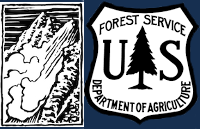This is Dave Zinn with the avalanche forecast on Tuesday, April 1st, at 7:30 a.m. sponsored by World Boards and Uphill Pursuits. This forecast does not apply to operating ski areas.
24-Hour Snow Totals (NO JOKE!)
- Bridger Range - 13” of snow (1.4” of snow water equivalent - SWE)
- West Yellowstone and Island Park - 7-10” of snow (0.7-0.9” SWE)
- Big Sky and Cooke City - 4-7” of snow (0.4-0.5” SWE)
This morning, snow is falling heavily, especially in the Bridger Range, and it is expected to continue through tomorrow, with the heaviest accumulation favoring the mountains around Bozeman and Big Sky. Temperatures are in the teens and 20s F with 10-20 mph winds from the west and southwest.
Today, the intensity of the snowfall and wind will be the main drivers of the avalanche danger. The mountains around Bozeman and Big Sky will receive an additional 10-12 inches of snow by tomorrow morning, with 5-8 inches near West Yellowstone, Island Park and Cooke City. Winds will be 10-20 mph from the west shifting to the north, and high temperatures will be in the 20s to low 30s F.
The Bridger Range was pounded by new snow last night, with over a foot of new snow falling in the last 12 hours. It is snowing heavily now, and the forecast calls for an additional foot by tomorrow morning. You don’t need to be an avalanche forecaster to know that conditions are dangerous and will only get more so with additional snow.
The largest and most dangerous avalanches will occur in wind-loaded terrain, where wind slab avalanches can break two feet deep and spread widely across slopes. Avoid terrain below corniced ridgelines where wind drifts are common and where you see evidence of recent wind-loading and instability, such as shooting cracks or textured or stiffened snow surface.
In non-wind-loaded terrain, storm slab avalanches can break within the new snow, and loose snow avalanches will start at a point, entraining significant volume as they race downhill. Watch for red flags, such as avalanching and shooting cracks, that indicate you should stay off steep terrain. Assess the snowpack for instability above the most recent melt-freeze crust with an extended column test as a final check.
The danger is rated CONSIDERABLE. Rapidly changing spring weather often leads to a dynamic evolution of avalanche conditions throughout the day. Regularly reassess conditions.
Snowfall totals in the mountains near Big Sky, West Yellowstone, Island Park, and Cooke City, and south of Bozeman have not matched the Bridger Range. There is up to 10 inches of snow around West Yellowstone and Island Park, and 4-6 inches elsewhere.
Human-triggered wind slab avalanches failing 1-2 feet deep on slopes with recent drifts are the primary concern, with high elevation slopes near ridgelines and below cornices being the most suspect. As skiers near Big Sky observed yesterday and Alex noted from Mount Blackmore, a stiffening of the snow surface or shooting cracks are indicators of potential instability (photo and info, video from Mt. Blackmore).
On slopes unaffected by the wind, dry loose avalanches that start at a point and entrain more snow as they slide are possible. I spent my weekend in Cooke City, where we triggered these loose snow slides, or sluffs, on steep pitches. These smaller avalanches are dangerous where they could push skiers or riders into or off terrain features, causing injury or burial in gullies and against trees. If snowfall rates increase during the day, storm slab avalanches could break and propagate wider.
Watch and test for instability above the thick melt-freeze crust formed in late March, and evaluate the potential consequences of an avalanche before skiing and riding steep slopes.
The avalanche danger is MODERATE.
Hyalite Road Closure
The Hyalite Canyon Road is closed to ALL MOTORIZED VEHICLES until the morning of May 16. This is a regular annual road closure to reduce road damage during the spring thaw. Bicycle and foot traffic are allowed. Contact the Bozeman Forest Service Ranger District for more info.
Eastern Oregon University is conducting a survey to better understand avalanche safety preparedness among motorized backcountry users like you. Your feedback will help us learn more about who is purchasing and practicing with avalanche rescue gear (beacon, probe, shovel) and participating in avalanche education. The survey is confidential and anonymous.
Your feedback is invaluable; please take a moment to share your experience and help us make a difference.



